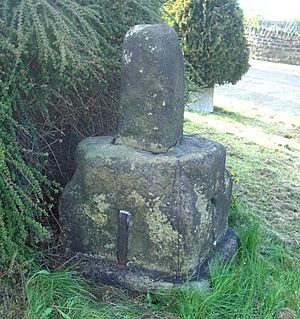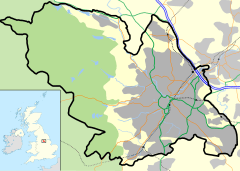Stannington, Sheffield facts for kids
Quick facts for kids Stannington |
|
|---|---|
 Stannington Cross |
|
| Population | 18,607 |
| Metropolitan borough | |
| Metropolitan county | |
| Region | |
| Country | England |
| Sovereign state | United Kingdom |
| Post town | SHEFFIELD |
| Postcode district | S6 |
| Dialling code | 0114 |
| Police | South Yorkshire |
| Fire | South Yorkshire |
| Ambulance | Yorkshire |
| EU Parliament | Yorkshire and the Humber |
| UK Parliament |
|
Stannington is a neighborhood in the city of Sheffield, England. It's found on the western edge of the main Sheffield city area. Stannington is part of the Bradfield local area. It also has its own local government area called the Stannington ward.
Contents
A Look at Stannington's Past
Stannington is located west of Sheffield city center. It sits on a hill between two rivers, the River Rivelin and the River Loxley.
Ancient Times: Roman Connections
People have lived in Stannington for a very long time. We know this because of things found from Roman times. Tablets found in the Rivelin Valley show that land was given to Roman soldiers who were retiring. These soldiers were from a group called the Sunuci tribe. Other Roman items have been found nearby on Walkley Bank Road.
Growing Through the Ages
Stannington started as two smaller settlements: Upper Gate and Nethergate. It was mentioned in the Middle Ages (a long time ago!). During that time, people in Stannington were given special permission. They could gather wood and let their cattle graze in the Rivelin forest. They paid a yearly fee for this right.
The old stone cross in Stannington is from this same period. It's called a "stump cross" and was likely put up in the 1200s or 1300s. You can still see it today where Oldfield Road and Stannington Road meet.
Stannington officially became part of Sheffield in 1974. Before that, it was part of a different district called Wortley. The older part of Stannington is still marked by a "Rural District of Wortley" sign. Newer parts, like Deer Park and Roscoe Bank, grew from the 1960s onwards.
Important Buildings in Stannington
Stannington has some important old buildings. These include:
- Christ Church parish church on Church Street.
- The Unitarian chapel, called Underbank Chapel.
- A large country house named Revell Grange.
All these buildings are special because they are "Grade II listed." This means they are protected because of their historical importance.
Getting Around Stannington
Stannington is connected to other parts of Sheffield by public transport. The Sheffield Supertram Bus route SL2 helps people travel between Stannington and Malin Bridge.
Stannington's Industrial History
In the early 1800s, Stannington became very important for making special bricks. These bricks were called "refractory bricks." They were used to line the inside of furnaces in the growing Sheffield steel industry. These bricks could handle very high temperatures.
What Were Refractory Bricks Made From?
The bricks were made from two main materials found in the area:
- Ganister: A type of sandstone.
- Fireclay: A special clay from the "Stannington pot clay seam."
Many mines and quarries for ganister and fireclay opened in Stannington. Local companies like Siddons Brothers and J & J Dyson were major producers.
The End of an Era
Making these special bricks started around 1810. However, this industry eventually stopped in 2012. The demand for these specific types of bricks changed. This was partly because new ways of making steel were developed. Also, the steel industry in Britain started to decline.


